First Aid for Soldiers FM 21-11
FM 21-11 First Aid for Soldiers: Chapter 4
First Aid for Fractures
Headquarters, Department of the Army, Washington, D.C., October 27, 1988
INTRODUCTION
A fracture is any break in the continuity of a bone. Fractures can cause total disability
or in some cases death. On the other hand, they can most often be treated so there is
complete recovery. A great deal depends upon the first aid the individual receives before
he is moved. First aid includes immobilizing the fractured part in addition to applying
lifesaving measures. The basic splinting principle is to immobilize the joints above
and below any fracture.
4-1. Kinds of Fractures
See Figure 4-1 for detailed illustration.

a. Closed Fracture. A closed fracture is a broken bone that does not break the
overlying skin. Tissue beneath the skin may be damaged. A dislocation is when a
joint, such as a knee, ankle, or shoulder, is not in proper position. A sprain is
when the connecting tissues of the joints have been torn. Dislocations and sprains
should be treated as closed fractures.
b. Open Fracture. An open fracture is a broken bone that breaks (pierces) the
overlying skin. The broken bone may come through the skin, or a missile such as a bullet
or shell fragment may go through the flesh and break the bone. An open fracture is
contaminated and subject to infection.
4-2. Signs/Symptoms of Fractures
(081-831-1000)
Indications of a fracture are deformity, tenderness, swelling, pain inability to move
the injured part, protruding bone, bleeding, or discolored skin at the injury site. A
sharp pain when the individual attempts to move the part is also a sign of a fracture. DO
NOT encourage the casualty to move the injured part in order to identify a fracture since
such movement could cause further damage to surrounding tissues and promote shock. If you
are not sure whether a bone is fractured, treat the injury as a fracture.
|
4-3. Purposes of Immobilizing Fractures
A fracture is immobilized to prevent the sharp edges of the bone from moving and
cutting tissue, muscle, blood vessels, and nerves. This reduces pain and helps prevent or
control shock. In a closed fracture immobilization keeps bone fragments from causing an
open wound and prevents contamination and possible infection. Splint to immobilize.
4-4. Splints, Padding, Bandages, Slings, and Swathes
(081-831-1034)
a. Splints. Splints may be improvised from such items as boards, poles,
sticks, tree limbs, rolled magazines, rolled newspapers, or cardboard. If nothing is
available for a splint, the chest wall can be used to immobilize a fractured arm and the
uninjured leg can be used to immobilize (to some extent) the fractured leg.
b. Padding. Padding may be improvised from such items as a jacket, blanket,
poncho, shelter half, or leafy vegetation.
c. Bandages. Bandages may be improvised from belts, rifle slings, bandoliers,
kerchiefs, or strips torn from clothing or blankets. Narrow materials such as wire or cord
should not be used to secure a splint in place.
d. Slings. A sling is a bandage (or improvised material such as a piece of
cloth, a belt and so forth) suspended from the neck to support an upper extremity. Also,
slings may be improvised by using the tail of a coat or shirt, and pieces torn from such
items as clothing and blankets. The triangular bandage is ideal for this purpose. Remember
that the casualty's hand should be higher than his elbow, and the sling should be applied
so that the supporting pressure is on the uninjured side.
e. Swathes. Swathes are any bands (pieces of cloth, pistol belts, and so
forth) that are used to further immobilize a splinted fracture. Triangular and cravat
bandages are often used as or referred to as swathe bandages. The purpose of the swathe is
to immobilize, therefore, the swathe bandage is placed above and/or below the
fracture--not over it. |
4-5. Procedures for Splinting Suspected Fractures
(081-831-1034)Before beginning first aid treatment for a fracture, gather whatever splinting
materials are available. Materials may consist of splints, such as wooden boards,
branches, or poles. Other splinting materials include padding, improvised cravats, and/or
bandages. Ensure that splints are long enough to immobilize the joint above and below the
suspected fracture. If possible, use at least four ties (two above and two below the
fracture) to secure the splints. The ties should be nonslip knots and should be tied away
from the body on the splint.
*a. Evaluate the
Casualty (081-831-1000). Be prepared to perform any necessary lifesaving measures.
Monitor the casualty for development of conditions which may require you to perform
necessary basic lifesaving measures. These measures include clearing the airway, rescue
breathing, preventing shock, and/or bleeding control.
WARNING (081-831-1000)
Unless there is immediate life-threatening danger, such as a fire or an explosion, DO
NOT move the casualty with a suspected back or neck injury. Improper movement
may cause permanent paralysis or death.
WARNING (081-831-1000)
In a chemical environment, DO NOT remove any protective clothing. Apply the
dressing/splint over the clothing.
b. Locate the Site of the Suspected Fracture. Ask the casualty for the
location of the injury. Does he have any pain? Where is it tender? Can he
move the extremity? Look for an unnatural position of the extremity. Look for a bone
sticking out (protruding).
c. Prepare the Casualty for Splinting the Suspected Fracture (081-831-1034).
(1) Reassure the casualty. Tell him that you will be taking care of him and that
medical aid is on the way.
(2) Loosen any tight or binding clothing.
(3) Remove all the jewelry from the casualty and place it in the casualty's pocket.
Tell the casualty you are doing this because if the jewelry is not removed at this time
and swelling occurs later, further bodily injury can occur.
NOTE
Boots should not be removed from the casualty unless they are needed to stabilize a
neck injury, or there is actual bleeding from the foot.
d. Gather Splinting Materials (081-831-1034). If standard splinting materials
(splints, padding, cravats, and so forth) are not available, gather improvised materials.
Splints can be improvised from wooden boards, tree branches, poles, rolled newspapers or
magazines Splints should be long enough to reach beyond the joints above and below the
suspected fracture site. Improvised padding, such as a jacket blanket, poncho, shelter
half, or leafy vegetation may be used. A cravat can be improvised from a piece of cloth, a
large bandage, a shirt, or a towel. Also, to immobilize a suspected fracture of an arm or
a leg, parts of the casualty's body may be used. For example, the chest wall may be used
to immobilize an arm; and the uninjured leg may be used to immobilize the injured leg.
NOTE
If splinting material is not available and suspected fracture CANNOT be splinted,
then swathes, or a combination of swathes and slings can be used to immobilize an
extremity.
e. Pad the Splints (081-831-1034). Pad the splints where they touch any bony
part of the body, such as the elbow, wrist, knee, ankle, crotch, or armpit. Padding
prevents excessive pressure to the area.
f. Check the Circulation Below the Site of the Injury (081-831-1034).
(1) Note any pale, white, or bluish-gray color of the skin which may indicate impaired
circulation. Circulation can also be checked by depressing the toe/fingernail beds and
observing how quickly the color returns. A slower return of pink color to the injured side
when compared with the uninjured side indicates a problem with circulation. Depressing the
toe/fingernail beds is a method to use to check the circulation in a dark-skinned
casualty.
(2) Check the temperature of the injured extremity. Use your hand to compare the
temperature of the injured side with the uninjured side of the body. The body area below
the injury may be colder to the touch indicating poor circulation.
(3) Question the casualty about the presence of numbness, tightness, cold, or tingling
sensations.
WARNING
Casualties with fractures to the extremities may show impaired circulation, such as
numbness, tingling, cold and/or pale to blue skin. These casualties should be
evacuated by medical personnel and treated as soon as possible. Prompt medical
treatment may prevent possible loss of the limb.
WARNING
If it is an open fracture (skin is broken; bone(s) may be sticking out), DO NOT
ATTEMPT TO PUSH BONE(S) BACK UNDER THE SKIN. Apply a field
dressing to protect the area. See Task 081-831-1016, Put
on a Field or Pressure
Dressing.
g. Apply the Splint in Place (081-831-1034).
(1) Splint the fracture(s) in the position found. DO NOT attempt to reposition or
straighten the injury. If it is an open fracture, stop the bleeding and protect the wound.
(See Chapter 2, Section II, for detailed information.)
Cover all wounds with field dressings before applying a splint. Remember to use the
casualty's field dressing, not your own. If bones are protruding (sticking out), DO NOT
attempt to push them back under the skin. Apply dressings to protect the area.
(2) Place one splint on each side of the arm or leg. Make sure that the splints reach,
if possible, beyond the joints above and below the fracture.
(3) Tie the splints. Secure each splint in place above and below the
fracture site with improvised (or actual) cravats. Improvised cravats, such as strips of
cloth, belts, or whatever else you have, may be used. With minimal motion to the injured
areas, place and tie the splints with the bandages. Push cravats through and
under the natural body curvatures (spaces), and then gently position improvised cravats
and tie in place. Use nonslip knots. Tie all knots on the splint away from the casualty (Figure 4-2). DO NOT tie cravats directly over suspected
fracture/dislocation site.
|

|
h. Check the Splint for Tightness (081-831-1034).
(1) Check to be sure that bandages are tight enough to securely hold splinting
materials in place, but not so tight that circulation is impaired.
(2) Recheck the circulation after application of the splint. Check the skin
color and temperature. This is to ensure that the bandages holding the splint in place
have not been tied too tightly. A finger tip check can be made by inserting the tip of the
finger between the wrapped tails and the skin.
(3) Make any adjustment without allowing the splint to become ineffective.
i. Apply a Sling if Applicable (081-831-1034). An improvised sling may be made
from any available nonstretching piece of cloth, such as a fatigue shirt or trouser,
poncho. or shelter half. Slings may also be improvised using the tail of a coat, belt, or
a piece of cloth from a blanket or some clothing. See Figure 4-3
for an illustration of a shirt tail used for support. A pistol belt or trouser belt also
may be used for support (Figure 4-4). A sling should place the
supporting pressure on the casualty's uninjured side. The supported arm should have the
hand positioned slightly higher than the elbow. |
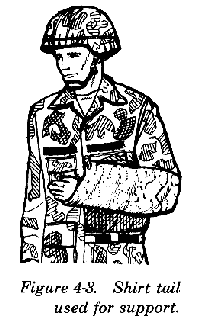
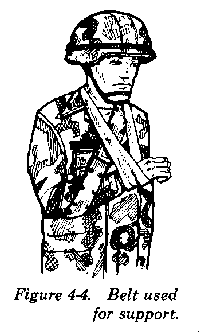
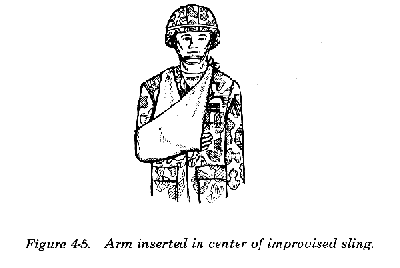
(2) Bring the ends of the sling up and tie them at the side (or hollow) of the neck on
the uninjured side (Figure 4-6).
|
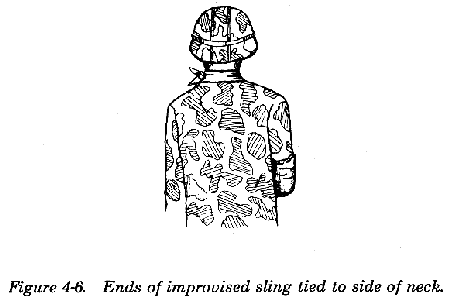
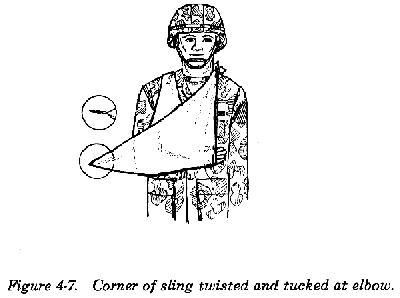
|
j. Apply a Swathe if Applicable (081-831-1034). You may use any large piece
of cloth, such as a soldier's belt or pistol belt, to improvise a swathe. A swathe is any
band (a piece of cloth) or wrapping used to further immobilize a fracture. When splints
are unavailable, swathes, or a combination of swathes and slings can be used to immobilize
an extremity.
WARNING (081-831-1034)
The swathe should not be placed directly on top of the injury, but positioned either
above and/or below the fracture site.
(1) Apply swathes to the injured arm by wrapping the swathe over the injured arm,
around the casualty's back and under the arm on the uninjured side. Tie the ends on the
uninjured side (Figure 4-8).
|

(2) A swathe is applied to an injured leg by wrapping the swathe(s) around both legs
and securing it on the uninjured side.
k. Seek Medical Aid. Notify medical personnel, watch closely for development
of life-threatening conditions, and if necessary, continue to evaluate the casualty.
|
4-6. Upper Extremity Fractures
(081-831-1034)
|
Figures 4-9 through 4-16 show how to apply slings, splints, and
cravats (swathes) to immobilize and support fractures of the upper extremities.
Although
the padding is not visible in some of the illustrations, it is always preferable to apply
padding along the injured part for the length of the splint and especially where it
touches any bony parts of the body.
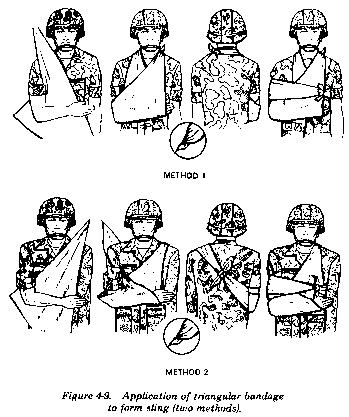

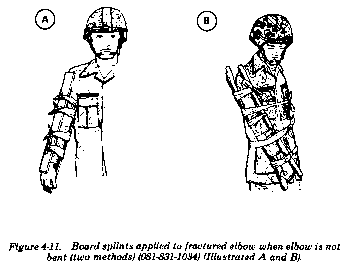

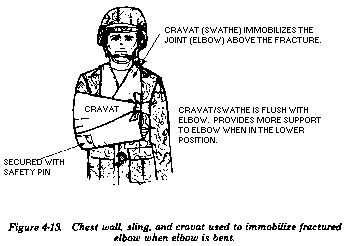
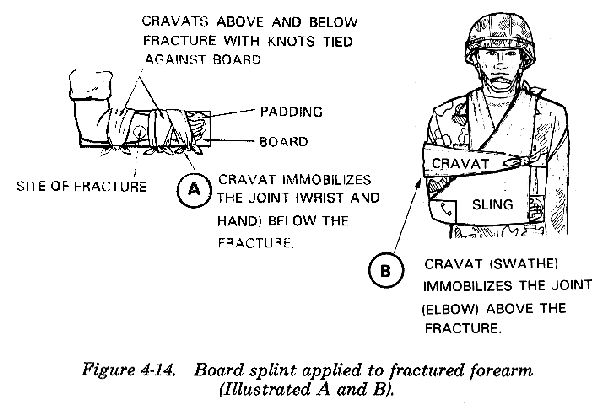
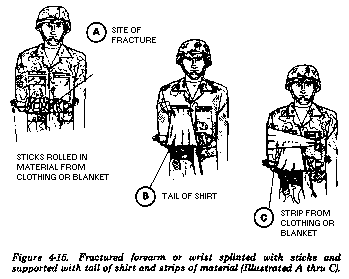
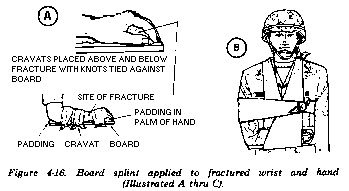
|
4-7. Lower Extremity Fractures (081-831-1034)
|
Figures 4-17 through 4-22 show how to apply splints to
immobilize fractures of the lower extremities. Although padding is not visible in some
of the figures, it is preferable to apply padding along the injured part for the length of
the splint and especially where it touches any bony parts of the body.


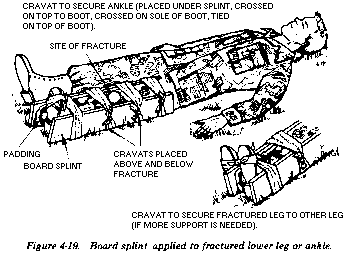
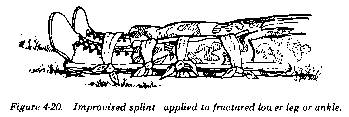
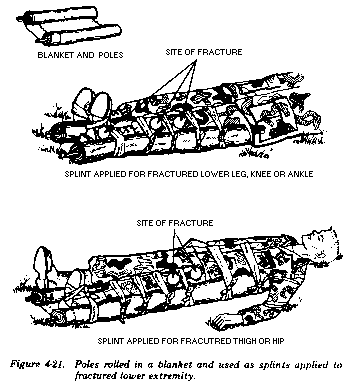

4-8. Jaw, Collarbone, and Shoulder Fractures
a. Apply a cravat to immobilize a fractured jaw as illustrated in Figure 4-23. Direct all bandaging support to the top of the
casualty's head, not to the back of his neck. If incorrectly placed, the bandage will pull
the casualty's jaw back and interfere with his breathing.

CAUTION
Casualties with lower jaw (mandible) fractures cannot be laid flat on their backs
because facial muscles will relax and may cause an airway obstruction.
b. Apply two belts, a sling, and a cravat to immobilize a fractured
collarbone, as illustrated in Figure 4-24.

c. Apply a sling and a cravat to immobilize a fractured or dislocated
shoulder, using the technique illustrated in Figure 4-25.

4-9. Spinal Column Fractures
(081-831-1000)
It is often impossible to be sure a casualty has a fractured spinal column. Be
suspicious of any back injury, especially if the casualty has fallen or if his back has
been sharply struck or bent. If a casualty has received such an injury and does not have
feeling in his legs or cannot move them, you can be reasonably sure that he has a severe
back injury which should be treated as a fracture. Remember, if the spine is fractured,
bending it can cause the sharp bone fragments to bruise or cut the spinal cord and result
in permanent paralysis (Figure 4-26 A). The spinal column must
maintain a swayback position to remove pressure from the spinal cord.
a. If the Casualty Is Not to Be Transported (081-831-1000) Until Medical Personnel
Arrive--
-
Caution him not to move. Ask him if he is in pain or if he is unable to move any part of
his body.
-
Leave him in the position in which he is found. DO NOT move any part of his
body.
-
Slip a blanket, if he is lying face up, or material of similar size, under the arch of
his back to support the spinal column in a sway back position (Figure
4-26 B). If he is lying face down, DO NOT put anything under any part of his body.
|
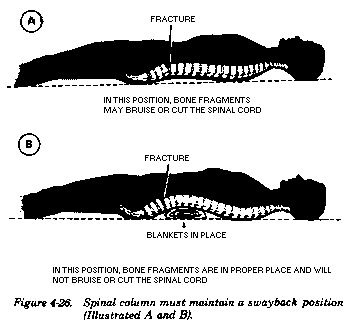
b. If the Casualty Must Be Transported to A Safe Location Before Medical Personnel
Arrive--
-
And if the casualty is in a face-up position, transport him by litter or use a firm
substitute, such as a wide board or a flat door longer than his height. Loosely tie the
casualty's wrists together over his waistline, using a cravat or a strip of cloth. Tie his
feet together to prevent the accidental dropping or shifting of his legs. Lay a folded
blanket across the litter where the arch of his back is to be placed. Using a four-man
team (Figure 4-27), place the casualty on the litter without
bending his spinal column or his neck.
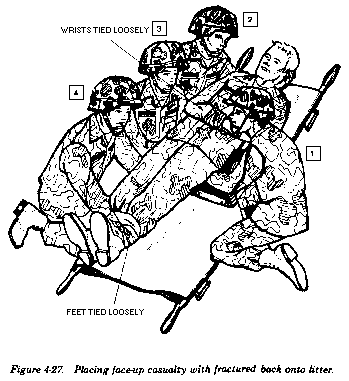
o The number two, three, and four men position themselves on one side
of the casualty; all kneel on one knee along the side of the casualty. The number one
man positions himself to the opposite side of the casualty. The number two, three,
and four men gently place their hands under the casualty. The number one
man on the opposite side places his hands under the injured part to assist.
o When all four men are in position to lift, the number two man commands,
"PREPARE TO LIFT" and then, "LIFT." All men, in unison, gently lift
the casualty about 8 inches. Once the casualty is lifted, the number one man recovers
and slides the litter under the casualty, ensuring that the blanket is in proper
position. The number one man then returns to his original lift position (Figure 4-27).
o When the number two man commands, "LOWER CASUALTY," all men, in
unison, gently lower the casualty onto the litter.
-
And if the casualty is in a face-down position, he must be transported in this same
position. The four-man team lifts him onto a regular or improvised litter, keeping the
spinal column in a swayback position. If a regular litter is used, first place a folded
blanket on the litter at the point where the chest will be placed.
4-10. Neck Fractures
(081-831-1000)
|
A fractured neck is extremely dangerous. Bone fragments may bruise or cut the spinal
cord just as they might in a fractured back.
|
a. If the Casualty Is Not to Be Transported (081-831-1000) Until Medical Personnel
Arrive--
-
Caution him not to move. Moving may cause death.
-
Leave the casualty in the position in which he is found. If his neck/head is in an
abnormal position, immediately immobilize the neck/head. Use the procedure stated
below .
o Keep the casualty's head still, if he is lying face up, raise his shoulders
slightly, and slip a roll of cloth that has the bulk of a bath towel under his neck (Figure 4-28). The roll should be thick enough to arch his neck
only slightly, leaving the back of his head on the ground. DO NOT bend his neck or head
forward. DO NOT raise or twist his head . Immobilize the casualty's head (Figure 4-29). Do this by padding heavy objects such as rocks or
his boots and placing them on each side of his head. If it is necessary to use boots,
first fill them with stones, gravel sand, or dirt and tie them tightly at the top. If
necessary, stuff pieces of material in the top of the boots to secure the contents.
|
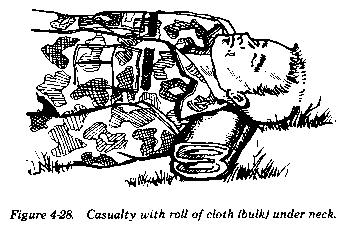

o DO NOT move the casualty if he is lying face down. Immobilize the head/neck by
padding heavy objects and placing them on each side of his head. DO NOT put a roll of
cloth under the neck. DO NOT bend the neck or head, nor roll the casualty onto his back.
b. If the Casualty Must be Prepared for Transportation Before Medical Personnel
Arrive--
-
And he has a fractured neck, at least two persons are needed because the casualty's head
and trunk must be moved in unison. The two persons must work in close coordination (Figure 4-30) to avoid bending the neck.
-
Place a wide board lengthwise beside the casualty. It should extend at least 4 inches
beyond the casualty's head and feet (Figure 4-30 A).
-
If the casualty is lying face up, the number one man steadies the
casualty's head and neck between his hands. At the same time the number two man
positions one foot and one knee against the board to prevent it from slipping, grasps the
casualty underneath his shoulder and hip, and gently slides him onto the board (Figure 4-30 B).
-
If the casualty is lying face down, the number one man steadies the
casualty's head and neck between his hands, while the number two man gently rolls
the casualty over onto the board (Figure 4-30 C).
-
The number one man continues to steady the casualty's head and neck. The number
two man simultaneously raises the casualty's shoulders slightly, places padding
under his neck, and immobilizes the casualty's head (Figures 4-30 D
and E). The head may be immobilized with the casualty's boots, with stones rolled in
pieces of blanket, or with other material.
-
Secure any improvised supports in position with a cravat or strip of cloth extended
across the casualty's forehead and under the board (Figure 4-30 D).
-
Lift the board onto a litter or blanket in order to transport the casualty (Figure 4-30 E).

|
































